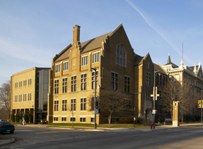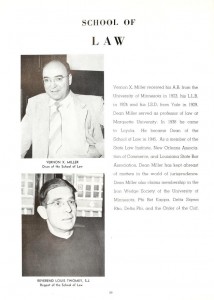Marquette Law School’s Enduring Connection to the Sports Law Industry
 As noted in an earlier post, the current issue of Marquette Lawyer magazine contains a profile of the current Marquette Sports Law program and the National Sports Law Institute. What the article fails to note, however, it that the law school’s involvement with the sports industry long pre-dates the founding of the National Sports Law Institute in 1989.
As noted in an earlier post, the current issue of Marquette Lawyer magazine contains a profile of the current Marquette Sports Law program and the National Sports Law Institute. What the article fails to note, however, it that the law school’s involvement with the sports industry long pre-dates the founding of the National Sports Law Institute in 1989.
Marquette law students have gone on to careers as major league athletes and coaches; Marquette law graduates helped create the category of sports lawyer, and Marquette law professors have played important roles in the sports industry and in the creation of the academic discipline of sports law. And this was all before the Second World War.
Early in its history, when admission to the law school required less than four years of college, many Marquette law students competed on Marquette varsity sports teams, and a number of these ended up playing in the National Football League—including Green Bay Packer Hall-of-Famer LaVern “Lavvie” Dilweg, and fellow-Packers Larry McGinnis and Biff Taugher—and in the predecessor to the National Basketball League—including Frank Zummach (as a coach) and Ed “Boops” Mullen (as a player). Paul Robeson, who was never officially enrolled in the law school, reportedly studied with a Marquette law professor while playing for the NFL’s Milwaukee Badgers in the 1920’s, before he embarked on his better known careers in music, theater, and politics.
Future Congressman Ralph Metcalfe was a world class sprinter and an Olympic medal winner who also was enrolled in the law school in the 1930’s. And who can forget former Marquette law student and Hollywood actor Pat O’Brien? As a student, O’Brien unsuccessfully sought a spot on the Marquette football squad but later achieved a form of sports immortality by playing the lead role in “The Knute Rockne Story,” the film biography of the great Notre Dame football coach.
Raymond J. Cannon, a 1914 Marquette Law School graduate and a United States Congressman from 1933 to 1939, was arguably the first American lawyer to develop a sports-specific law practice, which he did in the late 1910’s and 1920’s. Cannon, also a star semi-pro baseball pitcher in Wisconsin from 1908-1922, was most famous for representing several of the so-called “Black Sox”–a group of eight Chicago White Sox players permanently expelled from Organized Baseball because of their involvement with efforts to fix the 1919 World Series–in their effort to recover unpaid salary and seek reinstatement.
Sympathetic to the plight of professional baseball players, whose occupational liberty he believed was unfairly restrained by the reserve clause, Cannon also attempted to organize a professional baseball players’ union. Called the National Baseball Players Association, Cannon’s organization was founded in 1922, while he was still much involved with the representation of the Black Sox.
Although many players from both the National and American leagues initially expressed enthusiasm for Cannon’s idea, few joined the new association, and the organization folded in 1924. Cannon’s simultaneous involvement with the Black Sox litigation and his continued representation of several of the group in the early 1920’s probably did not help matters. Most major league baseball players of that era were intimidated by the ruthlessly authoritarian tactics of baseball commissioner, Kenesaw Mountain Landis (a former Marquette Law School lecturer, discussed below), who appeared willing to ban players for life, even on the suspicion of association with gamblers.
After his involvement with the Black Sox cases ended, Cannon continued to represent legendary outfielder Shoeless Joe Jackson on a variety of matters for the remainder of his (Jackson’s) life.
Cannon’s sports-related practice also extended to boxing. In 1918, he began to work with Chicago boxing promoter, Tom Andrews, and did the legal work for a number of championship prize-fights, including Jack Dempsey matches with Fred Fulton, Jess Willard, and the Frenchman Georges Carpentier. In the early 1920’s, Cannon also became Dempsey’s personal lawyer, at a time that the fighter was the heavyweight boxing champion of the world and one of the best known celebrities in the United States. Among other services, Cannon helped Dempsey escape from an unfavorable managerial contract with John J. “John the Barber” Reiser, but his lawyer-client relationship with Dempsey ended later in the decade when he sued Dempsey for $20,000 in unpaid legal fees.
Cannon’s son, Robert C. Cannon, who graduated from the law school in 1941, was also a major figure in American sports. After a career as Milwaukee Circuit Court judge that began shortly after World War II, Cannon, a long time baseball fan, became the legal adviser and de facto director of the Major League Baseball Players Association in 1969, when he was chosen for that position after a national search by the players’ organization. Rather than resign from the bench, which he felt he would be required to do if he took a baseball salary, Cannon served for seven years as an active, but unpaid advisor to the Players Association.
Although Cannon was sometimes criticized as too sympathetic to the interests of the baseball owners to adequately represent the players, he was popular among both players and owners. In 1965, he was seriously considered for the position of Commissioner of Baseball when existing commissioner Ford Frick retired. Cannon eventually lost out to retired Air Force General William Eckert for the Commissioner position, but in 1966, he was offered and accepted the new post as full-time director of the Major League Baseball Players Association at a salary of $150,000. However, shortly after indicating he would be happy to accept the position, Cannon had second thoughts about leaving Milwaukee and his circuit court judgeship, and even though the Players Association offered to move its offices to Chicago, Cannon withdrew his acceptance. Having lost out on their first choice, the Players Association then turned to Marvin Miller. The rest, as they say, is history.
Marquette faculty members were also connected to the sports industry. The above-mentioned Kenesaw Mountain Landis taught at Marquette Law School as a lecturer in 1909 while he was a federal judge in Chicago. (He would not become Commissioner until 12 years later.) When current Commissioner Alvin “Bud” Selig joined the Marquette faculty this year as a Lecturer in Law, he filed a slot held 102 years earlier by his famous predecessor in his day job.
Elmer W. Roller, a 1923 graduate of Marquette Law School and a full-time Marquette law professor in the late 1920’s and 1930’s, suddenly became known to baseball fans all over the United States in 1965 when he almost kept the Milwaukee Braves from leaving town. (The new owners of the Braves had announced at the end of the 1964 season that they planned to be playing in Atlanta, Georgia, as early as 1966.)
As a Milwaukee County Circuit Court Judge, Roller ruled that the team’s planned relocation to Atlanta violated the Wisconsin Antitrust Act in a way that warranted injunctive relief. Roller ordered the National League to keep the Braves in Milwaukee or else replace them with another team. Unfortunately for Brew City baseball fans, Roller was subsequently overruled by the Wisconsin Supreme Court, and that decision was left standing by the United States Supreme Court in 1966.
Finally, the discipline of academic sports law really begins with two articles on the law of sports published in the Marquette Law Review in 1940 by legendary Marquette Law Professor, Carl Zollman. Although articles on the law of sports had been previously published in legal periodicals targeted to practitioners, these were the first two “academic articles” addressing sports law issues to appear in a law-school sponsored law review.
As I wrote in an earlier profile of Zollman:
Zollman’s final two law review articles, both of which appeared in the Marquette Law Review in 1940, were entitled “Baseball Peonage” and “Injuries from Flying Baseballs to Spectators at Ball Games.” The first was a study of baseball labor relations which focused on the restrictive nature of Organized Baseball’s reserve system, which Zollman actually thought was reasonable, and the second was an early examination of one of the classic problems in sports law. The two articles, particularly the first, reflect a detailed knowledge of the structure and history of professional baseball and suggest that Zollman must have been a long-time fan.
Given this history, it was entirely appropriate that the National Sports Law Institute was established at the Marquette Law School in 1989. It is too bad that so little of this history is currently acknowledged by the law school or the sports law program. Unfortunately, law schools tend to have short memories.

 As we settle into the second year of Eckstein Hall, it is interesting to look back and try to imagine what it would have been like to have been a student in Sensenbrenner Hall in its second year, 1925-1926.
As we settle into the second year of Eckstein Hall, it is interesting to look back and try to imagine what it would have been like to have been a student in Sensenbrenner Hall in its second year, 1925-1926.